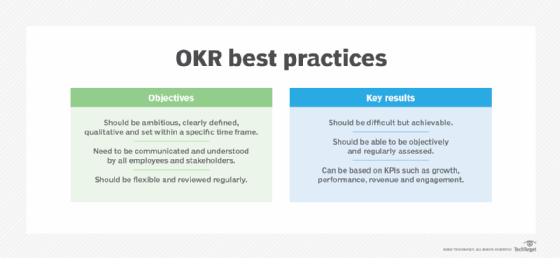OKRs (Objectives and Key Results)
What are OKRs (Objectives and Key Results)?
OKRs (Objectives and Key Results) encourage companies to set, communicate and monitor organizational goals and results in an effective, transparent manner. A dynamic performance management framework, OKRs focus on aligning business, team and individual objectives in a measurable, hierarchal way.
OKRs have two components: objectives and key results. Typically, three to five main goals are identified, each accompanied by three to five related, quantifiable action items or key performance indicators (KPIs). The objective describes what is to be accomplished; key results lay out a roadmap for achieving the goals in a specific time frame. Objectives should be ambitious and inspiring, sometimes called moonshots, to drive motivation and innovation. OKRs are reviewed and reevaluated periodically, often quarterly, to ensure relevance and effectiveness.
A fundamental goal of implementing OKRs is to promote organizational unity and clarity. Often, OKRs are directly associated with an organization's strategic plan.
By adopting OKRs, all employees gain awareness of the overarching organizational goals. The transparency, alignment and accountability that normally accompanies OKRs motivate employees and prompt them to work collaboratively to achieve the objectives. OKRs encourage setting high targets, with an emphasis on tracking progress through data-driven key results. Modern performance management software plays a crucial role in measuring and visualizing progress in real time, often allowing visibility into the goals of others within the organization, fostering a culture of transparency and collective effort.

Benefits of OKRs
Successful implementation of OKRs offers several benefits:
- Simplification of goal-setting processes, facilitating unity.
- Enhanced transparency regarding priorities, expectations and objectives.
- Stronger organizational and individual focus, motivation and productivity.
- Clear delineation of each employee's role in achieving long-term objectives.
Evolution of OKRs
Andy Grove, the former CEO of Intel, pioneered the OKR framework, drawing inspiration from Peter Drucker's Management by Objectives (MBO). While similar to MBO in requiring goals to be specific and time-bound, OKRs differ by emphasizing aggressive, aspirational objectives where complete achievement of key results is less critical than significant progress.
In recent years, leading companies like Google, LinkedIn, Uber and Wells Fargo have integrated OKRs into their operational model. As these organizations have evolved, so have their approaches to OKRs.
For example, Google, initially setting quarterly OKR goals, expanded to include annual objectives, aligning short- and long-term targets across all levels of the company, from engineers to the CEO. Under Alphabet, Google and its subsidiaries continue to employ OKRs, demonstrating the framework's adaptability to different scales and contexts. Sundar Pichai, current CEO of Google, has further adapted the framework, allowing employees to focus on one significant goal at a time, illustrating the flexibility of OKRs to cater to various organizational cultures and stages of growth.
Today, OKRs remain a vital tool for strategic planning and performance management. As businesses navigate an increasingly complex and fast-paced environment, the adaptability and clarity OKRs provide is more valuable than ever.
The framework's emphasis on ambitious goals and measurable results aligns with the need for agility and continuous improvement in modern organizations. Moreover, the widespread adoption of digital tools has enhanced the ability to track and share OKRs, making this methodology even more powerful and relevant in the current environment.
Information technology is a key part of developing an effective strategic plan. Look at these six free IT strategic planning templates that can help make IT a driving force in a business.





